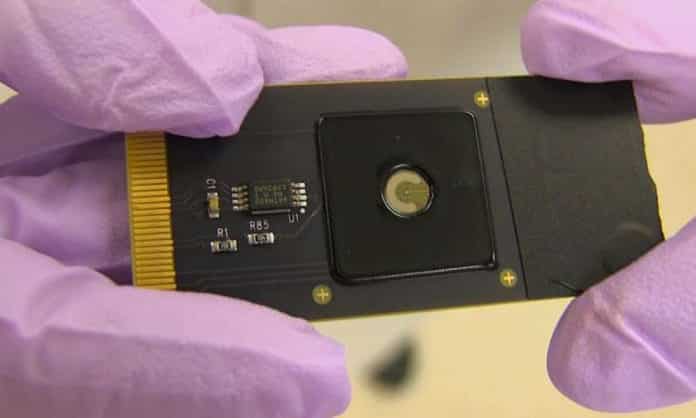
CRISPR Powered e-Transistors For Quick Genetic Mutation Detection
CRISPR-Chip – A CRISPR powered e-Transistor made of graphene is a new device developed by a group of engineers at the University of California, Berkeley & the Keck Graduate Institute (KGI) of The Claremont Colleges, that can detect a genetic mutation within minutes.
The device, called CRISPR-Chip, could be used to diagnose hereditary diseases or to evaluate the accuracy of gene-editing techniques.
“We’ve developed the first transistor that uses CRISPR to look for your genome for potential mutations,” said Kiana Aran, an assistant professor at KGI who imagined this tech while a postdoctoral scholar at UC Berkeley bioengineering professor Irina Conboy’s lab. “You just put your purified DNA sample on the processor, allow CRISPR to do the search and the graphene transistor reports the result of this search in minutes”
Physicians and geneticists can now order DNA to pinpoint genetic mutations underlying a multitude of
traits and conditions, and companies like 23andMe and AncestryDNA even make these tests available to curious consumers.But unlike most forms of genetic testing, for example recently developed CRISPR-based diagnostic methods, CRISPR-Chip uses nanoelectronics to detect genetic mutations in DNA samples without first”amplifying” or replicating the DNA segment of interest tens of thousands of times over through time- and an equipment-intensive procedure called polymerase chain reaction or PCR. This implies it could be used to perform genetic testing in a physician’s office or field work setting without needing to send off a sample to a lab.
“CRISPR-Chip has the benefit that it actually points of maintenance, it is one of the few things where you could do it at the bedside if you had a fantastic DNA sample,” explained Niren Murthy, professor of bioengineering at UC Berkeley and co-author of this paper. “Finally, you just have to take an individual’s cells, extract the DNA and combine it together with the CRISPR-Chip and you will have the ability to tell if a certain DNA sequence is there or not. That could possibly lead to a true bedside assay for DNA.”
The CRISPR-Cas9 process is famous for its capacity to snip threads of DNA at precise locations like a set of razor-sharp scissors, giving scientists unparalleled gene-editing capabilities. But in order to precisely cut & paste genes, the Cas9 protein first needs to identify the specific location from the DNA that it needs to alter. It then opens up the double-stranded DNA to scan through unless it locates the matching sequence that guides RNA and then latches on it.
To harness CRISPR’s gene-targeting skill, the investigators chose a spoonful Cas9 protein–a variant of Cas9 that can get a particular location on DNA but does not cut it – and tethered it to transistors made of graphene. After the CRISPR complex finds the spot on the DNA it is targeting, it binds to it and activates a shift in the electrical conductance of the graphite, which, in turn, alters the electric characteristics of the transistor. These changes can be identified with a hand-held apparatus developed by the team’s industrial collaborators.
Graphene, built of a single atomic layer of carbon dioxide, is so electrically sensitive it can detect a DNA chain”struck” at a full-genome sample without PCR amplification.
“CRISPR brought the selectivity, graphene transistors brought the sensitivity and, collectively, we had the ability to do this PCR-free or amplification-free detection.”
Aran hopes to “multiplex” the device, allowing doctors to plug multiple guide RNAs simultaneously to detect a number of genetic mutations in a few minutes.
“Envision a page with a lot of research boxes, in our instance transistors, and you have your guide RNA info in those search boxes, and each of these transistors will do the search and report the result electronically,” Aran said.
To illustrate CRISPR-Chip’s sensitivity, the group utilized the device to discover two common genetic mutations in blood samples from Duchenne muscular dystrophy (DMD) patients.
Conboy, the co-author of the paper, states CRISPR-Chip might be an especially useful instrument for DMD screening because the severe muscle-wasting disease can be caused by mutations through the massive dystrophin gene–among the longest in the human genome–and spotting mutations could be costly and time-consuming using PCR-based genetic testing.
“As a practice at the moment, boys who have DMD are typically not screened until we are aware that something is wrong, then they undergo a genetic confirmation,” said Conway, who is working on CRISPR-based treatments for DMD.
“Using an electronic device, you could design direct RNAs throughout the entire dystrophin gene, and then you can just screen the entire sequence of the receptor in a matter of hours. You could screen parents, or even newborns, for the existence or absence of dystrophin mutations–then, if the mutation is discovered, therapy could be started early, until the disease has really grown,” Conboy said.
Rapid genetic testing might also be utilized to help doctors develop individualized treatment programs for their patients, Murthy said. By way of instance, genetic variants make some people unresponsive to expensive blood thinners, such as Plavix.
“If you’ve got particular mutations or certain DNA sequences, then that will very accurately forecast how you will respond to certain medications,” Murthy said.
In the end, since the CRISPR-Chip may be used to monitor whether CRISPR binds to specific DNA sequences, it could also be used to test the effectiveness of CRISPR-based gene-editing practices. For instance, it might be employed to confirm that manual RNA sequences are designed correctly, Aran said.
“Combining modern nanoelectronics with contemporary biology opens a new door to find access to new biological information which wasn’t available before,” Aran said.





























